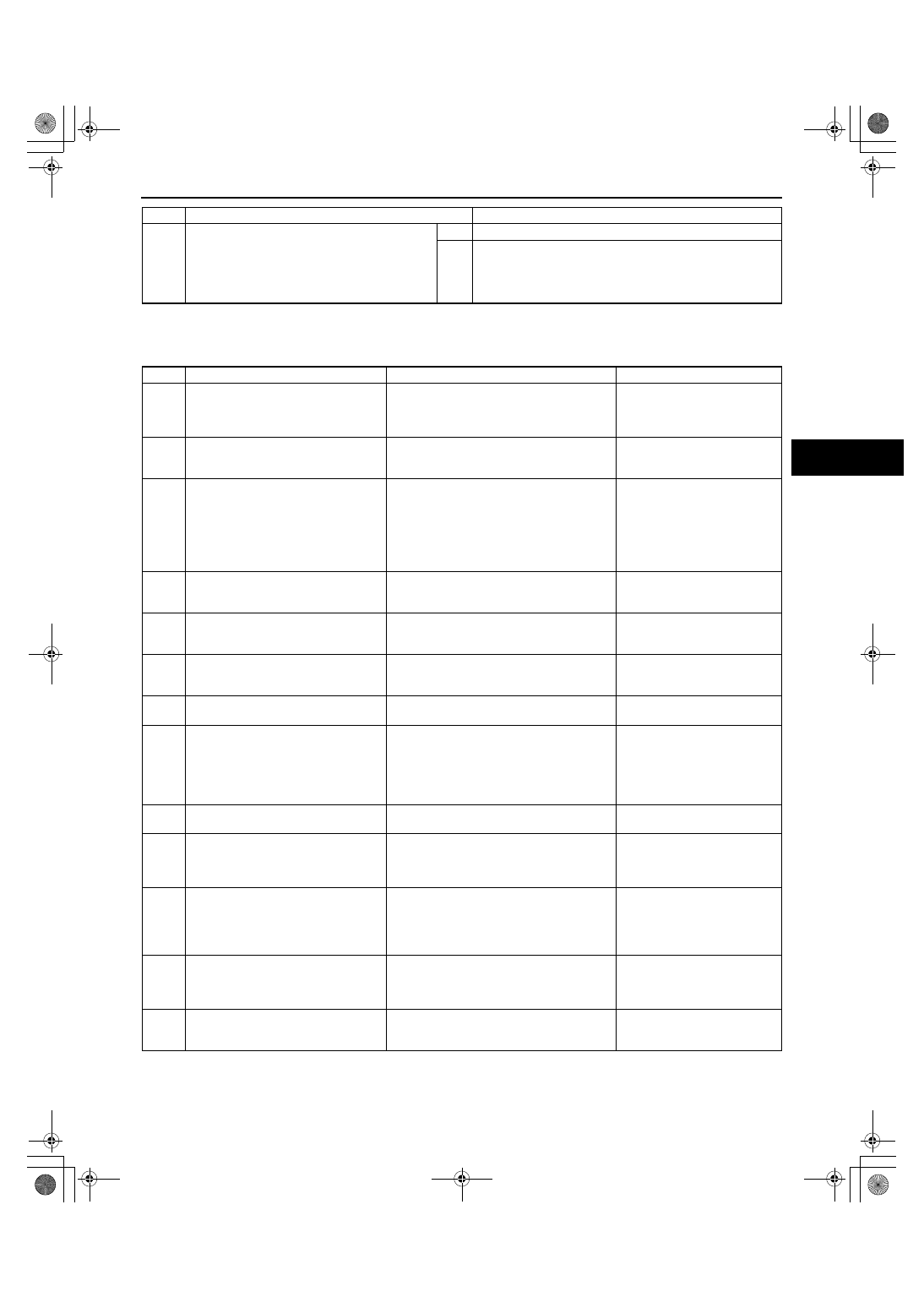Mazda Protege 5. Manual - part 237

SYMPTOM TROUBLESHOOTING
05–03–7
05–03
End Of Sie
AUTOMATIC TRANSAXLE SYMPTOM TROUBLESHOOTING ITEM TABLE
A3U050301030W04
•
Use the chart below to verify the symptoms of the trouble in order to diagnose the appropriate area.
5
•
Inspect the value at the following PIDs using
the WDS or equivalent.
(See 01–40A–7 PCM INSPECTION [ZM].)
(See 01–40B–7 PCM INSPECTION [FS].)
— TP, and VSS PIDs
•
Is PID value okay?
Yes
Perform symptom troubleshooting and follow procedures.
No
Repair or replace any defective parts according to
inspection result.
STEP
INSPECTION
ACTION
No.
TROUBLESHOOTING ITEM
DESCRIPTION
PAGE
1
•
Vehicle does not move in D, 2, 1
ranges, or in R position
•
Vehicle does not move when accelerator
pedal is depressed.
(See 05–03–11 NO.1
VEHICLE DOES NOT MOVE
IN D, 2, 1 RANGES, OR IN R
POSITION.)
2
•
Vehicle moves in N position
•
Vehicle creeps in N position.
•
Vehicle creeps if brake pedal is not
depressed in N position.
(See 05–03–11 NO.2
VEHICLE MOVES IN N
POSITION.)
3
•
Vehicle moves in P position, or
parking gear does not disengage
when P is disengaged
•
Vehicle rolls when on a downward slope
and tires do not lock in P position.
•
Tires are locked when P is disengaged.
Vehicle does not move in D, 2, 1 ranges,
and R position when accelerator pedal is
depressed, and engine remains in stall
condition.
(See 05–03–11 NO.3
VEHICLE MOVES IN P
POSITION, OR PARKING
GEAR DOES NOT
DISENGAGE WHEN P IS
DISENGAGED.)
4
•
Excessive creep
•
Vehicle accelerates in D, 2, 1 ranges,
and R position without depressing
accelerator pedal.
(See 05–03–11 NO.4
EXCESSIVE CREEP.)
5
•
No creep at all
•
Vehicle does not move in D, 2, 1 ranges,
or R position when idling on flat paved
road.
(See 05–03–12 NO.5 NO
CREEP AT ALL.)
6
•
Low maximum speed and poor
acceleration
•
Vehicle acceleration is poor at start.
•
Delayed acceleration when accelerator
pedal is depressed while driving.
(See 05–03–12 NO.6 LOW
MAXIMUM SPEED AND
POOR ACCELERATION.)
7
•
No shifting
•
Single shift range only.
•
Sometimes it shifts correctly.
(See 05–03–13 NO.7 NO
SHIFTING.)
8
•
Does not shift to fourth gear (4GR)
•
Vehicle does not upshift from 3GR to
4GR even though vehicle speed is
increased.
•
Vehicle does not shift to 4GR even
though accelerator pedal is released in
D range at 60 km/h {37 mph}.
(See 05–03–13 NO.8 DOES
NOT SHIFT TO FOURTH
GEAR (4GR).)
9
•
Abnormal shifting
•
Shift incorrectly (incorrect shift pattern).
(See 05–03–14 NO.9
ABNORMAL SHIFTING.)
10
•
Frequent shifting
•
Downshifting occurs immediately even
when accelerator pedal is depressed
slightly in D, 2, 1 ranges except O/D
OFF mode.
(See 05–03–14 NO.10
FREQUENT SHIFTING.)
11
•
Shift point is high or low
•
Shift point is considerably different from
automatic shift diagram.
•
Shift delayed when accelerating.
•
Shift occurs quickly when accelerating
and engine speed does not increase.
(See 05–03–14 NO.11 SHIFT
POINT IS HIGH OR LOW.)
12
•
Torque converter clutch (TCC)
non-operation
•
TCC does not operate when vehicle
reaches TCC operation range.
(See 05–03–15 NO.12
TORQUE CONVERTER
CLUTCH (TCC) NON-
OPERATION.)
13
•
No kickdown
•
Does not downshift when accelerator
pedal is fully depressed within kickdown
range.
(See 05–03–15 NO.13 NO
KICKDOWN.)
1712-1U-01G(05-03).fm 7 ページ 2001年6月29日 金曜日 午前10時8分